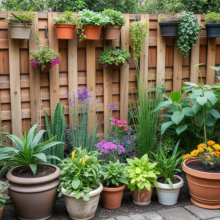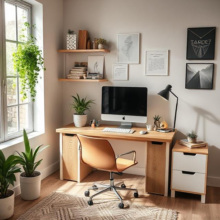Minimalist Home Decor DIY: Transform Your Space with Simplicity

 Introduction to Minimalist Home Decor DIY
Introduction to Minimalist Home Decor DIY
Minimalism is more than just a design trend—it’s a lifestyle. Rooted in simplicity, functionality, and intentionality, minimalist home decor focuses on creating clean, uncluttered, and stylish spaces that promote peace and harmony. DIY minimalist decor allows you to infuse your personality into your home while saving money and maintaining creative control.
In this guide, we’ll explore the principles of minimalist design, essential DIY materials, and step-by-step projects that will help you transform your living space without excess clutter. Whether you’re a seasoned DIY enthusiast or a beginner, these ideas will inspire you to create a stylish and tranquil home that reflects your aesthetic.
Before diving into DIY projects, it’s essential to understand what makes minimalist decor unique. Here are the core principles with practical applications:
- Simplicity – Less is more. Minimalist decor embraces clean lines, neutral colors, and functional designs.
- Example: Instead of a cluttered coffee table filled with decorative items, opt for a single ceramic vase with fresh flowers or a wooden tray with a scented candle.
- Functionality – Every piece should serve a purpose, whether it’s storage, decoration, or both.
- Example: Choose a sleek wall-mounted desk for a home office setup instead of a bulky workstation, ensuring both aesthetics and practicality.
- Aesthetic Balance – Creating a harmonious look by focusing on proportion, symmetry, and negative space.
- Example: In your living room, balance large furniture pieces with open space—if you have a large sofa, keep surrounding elements minimal, like a single framed artwork and a floor lamp.
- Decluttering – Keeping only the essentials and eliminating unnecessary items.
- Example: If your entryway is cluttered with shoes and accessories, install a concealed storage bench to keep items tucked away while maintaining a clean appearance.
- Quality Over Quantity – Investing in a few high-quality pieces rather than many disposable ones.
- Example: Instead of buying multiple plastic storage bins, invest in a few handcrafted wooden baskets or woven fabric organizers that are both durable and stylish.
By keeping these principles in mind, your DIY projects will align with the minimalist ethos and result in a beautiful, cohesive space.
Essential Materials and Tools for Minimalist DIY Projects
Minimalist DIY decor relies on simple, versatile, and natural materials. Here are some essentials:
Materials:
- Wood (e.g., reclaimed wood, plywood, birch)
- Neutral paint (white, beige, gray, earth tones)
- Metal accents (black, brass, or silver for a sleek finish)
- Glass and mirrors (to enhance natural light)
- Fabrics (linen, cotton, jute for a soft, organic feel)
- Eco-friendly adhesive and finishes
Tools:
- Drill and screws
- Paintbrushes and rollers
- Sandpaper and wood stain
- Measuring tape and level
- Glue gun and strong adhesive
With these materials and tools, you can execute a variety of minimalist DIY home decor projects with ease.
DIY Minimalist Home Decor Projects You Can Try
1. Floating Wooden Shelves
Why? Floating shelves are functional, visually light, and perfect for decluttering.
How to Make It:
- Cut wood to your desired shelf size.
- Sand and stain or paint in neutral colors.
- Attach metal brackets to the wall and mount the shelf.
- Style with a few books, candles, or small potted plants.
2. DIY Minimalist Wall Art
Why? Artwork can enhance aesthetics without overwhelming a space.
How to Make It:
- Use a blank canvas and paint abstract shapes in black, white, or muted tones.
- Create line art using a permanent marker for a Scandinavian-inspired look.
- Frame and hang it in a simple, sleek frame.
3. Handmade Clay Vases
Why? Simple vases add elegance and complement a minimalist theme.
How to Make It:
- Use air-dry clay to shape a small vase.
- Let it dry, then paint it in a neutral shade.
- Use it to display dried flowers or pampas grass.
4. Pegboard Wall Organizer
Why? Keeps your space tidy while adding a modern touch.
How to Make It:
- Get a wooden pegboard and cut it to your preferred size.
- Paint it in a neutral color.
- Attach pegs and shelves to organize items like keys, decor, or kitchen tools.
5. DIY Fabric Storage Bins
Why? These help keep clutter at bay while maintaining a soft, organic look.
How to Make It:
- Use sturdy fabric (linen or cotton) and sew a box-like structure.
- Add cardboard reinforcement inside.
- Use for organizing books, clothes, or miscellaneous items.
These projects not only enhance your space but also promote sustainability and personal creativity.
How to Maintain a Minimalist Home After DIY Transformations
Once you’ve created your minimalist space, keeping it that way requires mindful habits. Here are some tips:
- Declutter Regularly: Adopt a “one in, one out” rule to prevent accumulation.
- Maximize Storage: Use hidden storage solutions like under-bed bins and multi-functional furniture.
- Stick to a Neutral Color Palette: Avoid unnecessary visual clutter by sticking to a simple color scheme.
- Limit Decorative Items: Keep only a few statement pieces and avoid excessive decor.
By following these tips, you can maintain a serene and stylish minimalist home.
Common Mistakes to Avoid in Minimalist DIY Decor
Even in minimalism, it’s easy to go wrong. Here are mistakes to avoid:
- Overcomplicating Designs – Keep it simple; don’t add unnecessary details.
- Using Too Many Colors – Stick to neutral tones and avoid vibrant, overwhelming palettes.
- Neglecting Functionality – Every piece should serve a purpose in addition to looking good.
- Cluttering with “Minimalist” Items – Having too many “minimalist” decor pieces defeats the purpose.
Steering clear of these mistakes ensures your space stays intentional and uncluttered.
The Impact of Minimalist DIY Decor on Mental Well-being
Minimalist decor is not just about aesthetics—it affects mental clarity and well-being. Studies suggest that clutter-free environments reduce stress, enhance focus, and promote a sense of calm. By adopting minimalist DIY decor, you are creating a space that nurtures both physical and mental wellness.
Final Thoughts
Minimalist DIY home decor is a powerful way to personalize your space while keeping it functional, stylish, and clutter-free. By understanding minimalist principles, using the right materials, and implementing simple yet elegant projects, you can transform your home into a sanctuary of peace and creativity.
Are you ready to start your minimalist home decor journey? Share your favorite DIY project in the comments and let’s inspire each other!



